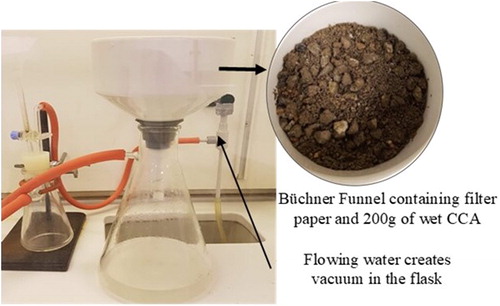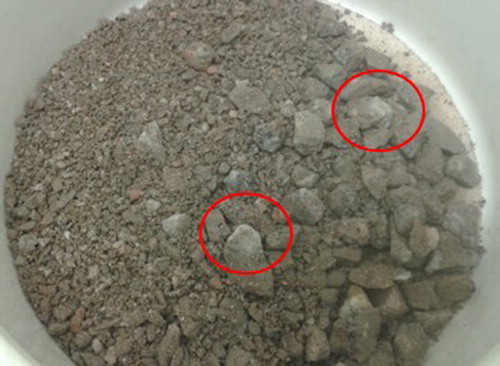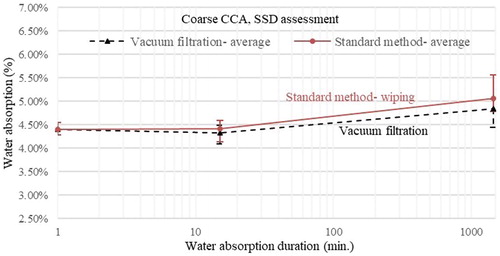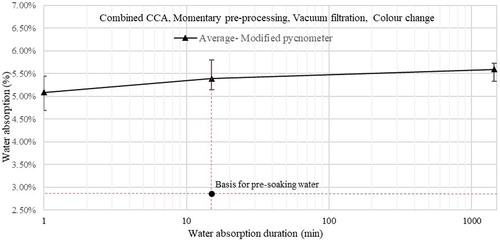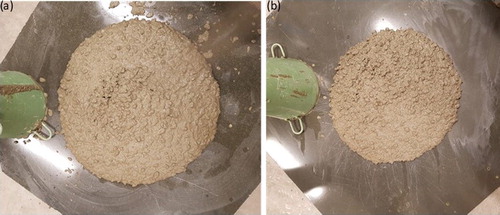 ?Mathematical formulae have been encoded as MathML and are displayed in this HTML version using MathJax in order to improve their display. Uncheck the box to turn MathJax off. This feature requires Javascript. Click on a formula to zoom.
?Mathematical formulae have been encoded as MathML and are displayed in this HTML version using MathJax in order to improve their display. Uncheck the box to turn MathJax off. This feature requires Javascript. Click on a formula to zoom.Abstract
The water absorption of crushed concrete aggregates (CCA) has a major influence on concrete workability. In order to determine the water absorption of CCA, a more porous material than natural aggregates, modifications to the standard pycnometer method are proposed as: (1) Water absorption is measured on a combined fraction CCA consisting of fine and coarse aggregates proportioned according to concrete recipe. (2) The CCA is pre-processed to mitigate sedimentation. (3) Saturated surface dry condition of aggregate is assessed by vacuum filtration and ocular technique. Water absorption development is measured at 0 min, 15 min, and 24 h. About 90% of the 24-h water absorption occurs in 15 min, value which is introduced in the concrete recipe; slump flow and compressive strength are determined. The modified pycnometer method shortens test duration, is operator insensitive and gives reliable water absorption result for CCA leading to concrete workability fitting industrial application.
1. Introduction
Recycling of concrete waste prolongs the technical life of concrete. Producers of ready-mixed and prefabricated concrete have the benefit of internally recycling their own waste. By substituting natural aggregates with own crushed concrete aggregates (CCA) a supply of homogeneous waste is made available for high utility applications [Citation1].
The CCA is more porous than other aggregates due to the cement paste surrounding its surface [Citation2, Citation3] leading to a relatively higher water absorption. Therefore, the measurement of the water absorption of CCA is critical to optimize the amount of the mixing water in the concrete for workability and compressive strength comparable to the reference concrete. Previous research shows that pre-soaking the porous recycled aggregates before mixing gives better control on workability [Citation4, Citation5] and higher slump [Citation6]. Pre-soaking is advantageous even for compressive strength as reported by Oliveira et al. [Citation7] who noticed higher compressive strength for concrete produced with semi-saturated recycled aggregates compared to dry or fully saturated aggregates.
The pycnometer method is widely used to measure the water absorption of coarse and fine aggregates by immersing the aggregate fractions in water for 24 h according to SS-EN 1097-6 [Citation8], ASTM C128 [Citation9]. The water absorption of aggregates is calculated as the ratio of the difference between the weight of the aggregates in saturated surface dry (SSD) condition and oven-dry condition to the weight of oven dry aggregates. The aggregates are in SSD condition when they are saturated with water fromwithin, while dry on the surface. The angular shape of the fines and the surface-adhered cement paste affects water absorption of fine CCA using this method. The technical challenges are to combat sedimentation and assess SSD [Citation10, Citation11].
While testing the water absorption using the pycnometer, the finer particles tend to settle and fill the voids causing sedimentation of fine CCA [Citation10]. Sedimentation can also occur due to the potential hydration capacity of cement paste adhered to the fine particles [Citation12]. The need of chemical agents is obvious for counteracting sedimentation. Rodrigues et al. [Citation10] pre-soaked their aggregates in a clay dispersant solution of Sodium hexametaphosphate and they observed that sedimentation was prevented. For the same reason in the Swedish FAS method [Citation13] the medium for water absorption is replaced with sodium diphosphate solution instead of the standard water medium.
Saturated surface-dried state assessed by the sand absorption cone technique in the pycnometer method is highly operator dependent especially for fine CCA having angular shape and surface roughness [Citation11, Citation14]. Other methods to assess SSD state are drying or evaporometry methods measuring drying rates by continuous drying and weighing procedures [Citation11, Citation15, Citation16]; mechanical methods using centrifuging to release water from the surface [Citation17]; combination methods of drying and centrifuging [Citation18]. Vacuum filtration method is found to be effective in removing the free water and surface water in sludge in comparison to other dewatering techniques such as centrifuging [Citation19].
The duration of water absorption test is 24 h [Citation8]; however, investigations from previous research show that most of the water absorption of recycled aggregates occur within the first 15 min [Citation6, Citation10].
The pycnometer method investigates fine and coarse aggregates separately, however, a combination of fine and coarse aggregates have earlier been used for water absorption of aggregates in infrastructure research [Citation20, Citation21]. Hall’s investigation on particle density and water absorption of combined aggregate samples correlate well with his results of individual aggregate samples [Citation20].
2. Research significance
The subject of this study is a modification of the pycnometer method in order to address the challenges for assessing the water absorption of CCA. The primary aim is to have a robust method, which is reliable, less operator sensitive and bridges the problems with assessment of water absorption of fine CCA. Using the results of this method concrete workability of industrial quality can be achieved. Novel features include test samples of combined fraction, preprocessing for the mitigation of sedimentation and saturated surface dry state assessment with an objective ocular technique, see workflow in . The secondary aim is to make minimum changes in the reference concrete mix as it is an industrially active recipe.
The water cement ratio is kept constant and natural aggregates are exchanged with 100% CCA, which is a beneficial way to go from conventional to CCA concrete in industrially active recipes. This will also have a positive effect on the environment as the cement amount remains unchanged.
3. Materials and methods
The modified pycnometer method investigates the water absorption of concrete rubble derived from prefabricated industrial reject of grade C40/50 intended to replace 100% of the aggregates in a concrete recipe.
3.1. Aggregate grading
The aggregates in the reference concrete are crushed stone of size 8/11.2 mm and naturally graded aggregate 0/8 mm mixed in the ratio of 47% and 53%, respectively. Aggregate fractions are replaced with concrete rubble crushed using a jaw crusher and sieved to CCA fractions of 8/11.2 mm and 0/8 mm. The grading curves for the natural aggregates and the CCA are assessed according to SS-EN 933-1 [Citation22], see ,b).
The 0/8 mm CCA has a coarser grading than the 0/8 mm natural sand () as also reported by Buyle-Bodin et al. [Citation23]. CCA grading is modified into three fractions (8/11.2 mm and two new fine fractions 0.5/4 mm and 0/4 mm) in order to match the grading of reference concrete as matching grading curves are considered to yield concrete of same workability [Citation24]. Correspondingly, the fineness modulus is determined by SS-EN 12620 + A1: 2008 [Citation25].
3.2. Combined fraction CCA test samples for water absorption
In this study, the water absorption is tested on a combined fraction containing the coarse fraction 8/11.2 mm and the new fine fractions 0.5/4 mm and 0/4 mm in the ratio of 45%, 35%, and 20% according to the concrete recipe.
Standard specifications [Citation8, Citation9] investigate the water absorption of coarse and fine fractions individually. This study, however, measures the water absorption of a combined fraction CCA because of the apparent difficulties with testing the fine fractions individually. In addition, the amount of water absorbed by the combined fraction CCA can be practically applied to the mixing procedure where the aggregates are similarly combined.
The reliability of the combined fraction as a test sample for water absorption is shown by comparing the apparent density of the combined fraction with the apparent density of the individual CCA fractions. The apparent density, measured according to SS-EN 1097-6 [Citation8], is used as a base for comparison as it is measured for each aggregate sample while immersed in water within the pycnometer.
3.3. Pre-processing the combined fraction CCA
Sedimentation of CCA particles is observed when the water absorption of CCA is measured in distilled water by the standard pycnometer method. Thus, the CCA is chemically pre-processed using a particle dispersant solution of polycarboxylate-based superplasticizer with distilled water (concentration of 6.35 g/L). The superplasticizer is the same as in the reference concrete recipe. No special compatibility analysis has been made for the superplasticizer as to whether it fits the concrete with CCA and thus nor is the influence of the superplasticizer on the water absorption investigated.
Individual coarse and fine CCA fractions are sampled according to SS-EN 933-1 [Citation26] to prepare a combined fraction CCA weighing 200 ± 1 g. The combined fraction CCA is pre-soaked momentarily in the superplasticizer solution such that the solution just covers the surface of the CCA before oven drying.
The pre-processed CCA is oven-dried at 110 ± 5 °C before it is introduced in the pycnometer containing the superplasticizer solution. Oven drying the CCA drains away the excess pre-soaking solution faster and helps to start the water absorption of the CCA at a uniform base level. Heating the CCA to 110 ± 5 °C might change the micro porosity and subsequently the CCA water absorption generally between 0.3 and 0.4% [Citation27].
3.4. SSD assessment by vacuum filtration
The combined CCA fraction is brought to SSD condition by draining the surface water by vacuum filtration instead of oven drying or wiping the aggregate as prescribed by SS-EN 1097-6 [Citation8].
The vacuum filtration set up shown in consists of a conical flask bearing a Buchner funnel containing qualitative filter paper (cotton linters – grade 3) that retains particles of size more than 10 µm. Vacuum pressure, 10–12 Pa, is created in the flask by an adjoining tap with flowing water connected to the flask by a hose arrangement. The contents of the pycnometer of 200 g wet CCA are poured through the Büchner funnel. Moist filter paper is placed on the CCA sample to prevent water loss by evaporation.
This method gives ocular feedback in the critical moments when the coarse CCA loses surface water and starts changing color as they begin to dry as seen in . The sudden color change in coarse aggregate is proposed as a criterion for SSD condition and signifies the termination of the filtration procedure and the end of the water absorption. The color change occurs repeatedly, is objectively noticeable to the operator, and enhances the reliability compared to the standard method.
3.5. Preparation of concrete mixes and casting
This study investigates two mixes: the reference concrete and the CCA concrete having the same water–cement ratio of 0.5 but with altered aggregate types, size fractions and accounted water absorption for CCA. Due to modifications of the grading curve, the coarse aggregate content of the CCA concrete is 2% less by weight than that of reference concrete. The cement used in the mixes is CEM II/A-LL 42.5 R. The recipe uses a polycarboxylate-based superplasticizer with a dry content of 24 ± 1 weight percentage. Reference and CCA concrete mixes are shown in .
Table 1. Concrete recipe for the reference and CCA concrete mixes.
Before mixing, the CCA are momentarily pre-soaked with 50% of the 15-min water absorption value as presented later in the results and discussion chapter.
The concrete mixing is a two-staged mixing process similar to Tam et al. [Citation28] and Pepe et al. [Citation29] where the mixing water is dosed in stages to enable cement paste to cover the CCA surface therefore strengthening the CCA-cement paste interface while the mixing is ongoing.
The pre-soaked CCA are mixed and drained for a minute. Following the addition of cement and a mixing duration of 90 s, 70% of the mixing water and super-plasticizer are dosed and the contents are mixed for a minute. Finally, the remaining water and superplasticizer are added and mixed for 10 min. The concrete volume mixed in this study is 20 liters. The mixing and slump flow procedure together take 15 min.
The workability of the fresh concrete is determined by measuring the slump flow diameter according to SS-EN 12350-5. Cylinder specimens of size 100 mm × 200 mm are cast, demolded after 24-h and cured for 28 days submerged in a curing tank with water at 20 ± 2 °C according to EN 12390-2 [Citation30].
4. Results and discussion
The results of the modified pycnometer method shown in this chapter are used to determine the pre-soaking water content before concrete mixing to ensure good workability of a CCA concrete with modified aggregate grading. The slump flow immediately after mixing and compressive strength at 28 days is tested.
4.1. Aggregate grading
Grading curves in show a lack of fines in 0/8 mm CCA fraction and this is compensated with new CCA fractions 0/4 mm and 0.5/4 mm to match the grading curves of reference concrete. The modified CCA grading is achieved by gap-grading see , where the grading curves are in reasonable agreement.
Gap-grading can reduce particle interference [Citation31] and in this case the absence of 4–5.6 mm fractions allows the finer CCA to pass between the coarse CCA and thus positively affect the flow characteristics of the fresh concrete.
The fineness modulus of the modified CCA is now comparable with the reference concrete, .
Table 2. Fineness moduli of CCA and reference concrete aggregates.
With agreeing grading curves and fineness modulus, the modified grading is considered for application in the concrete recipe.
4.2. Apparent density of combined fraction CCA test sample
The apparent density of the combined fraction CCA and natural aggregates is assessed and matches the calculated mean apparent density of the individual fractions; see , qualifying the combined fraction as a suitable test sample for the modified pycnometer method. The apparent density of coarse CCA, 2660 kg/m3 is less than that of natural coarse aggregate, 2740 kg/m3 and as the coarse aggregates have the most influence on the compressive strength, the differences show in less compressive strength, see Section 4.6.
Table 3. Apparent density of individual and combined CCA fractions by SS-EN 1097-6.
4.3. Vacuum filtration technique for SSD assessment
The vacuum filtration technique ensures minimal loss of fines and takes less time for the aggregates to attain SSD condition than oven drying. The sudden color change serves as an ocular assessment technique for the SSD and is used to measure the water absorption development of the CCA from an instant to 24 h.
Validation of standard and modified pycnometer is tested on coarse CCA, for 3 samples at each duration.
shows that the difference in mean value for each duration is less than 0.25%; the spread is similar for the 2 methods at each duration reflecting a good reliability of the modified method.
4.4. SSD assessment criteria
The criterion for stopping the draining of the aggregates is critical for assessment of SSD and thus for the water absorption results. The proposed color change criterion for SSD assessment of combined CCA occurs repeatedly every trial and is objectively noticeable thus making it dependable and operator insensitive.
4.5. Pre-soaking water for concrete mixing
In , the water absorption development is shown for combined CCA: momentarily pre-processed, vacuum filtered with SSD assessment by color change.
Three specimens each are investigated for momentary, 15 min and 24 h duration of water absorption, with a maximum spread of less than 1% of the results. More than 90% of the 24-h water absorption occurs at 15 min. Moreover, there is no significant change in water absorption development from 15 min to 24 h. This is in accordance with findings of Rodrigues et al. [Citation10] and Mefteh et al. [Citation6] who measured 80% respectively 90% of the 24 h water absorption for CCA at 15 min.
Our study shows that pre-soaking CCA by 50% of the 15-min water absorption value results in slump flow diameter of category F2 which precedes the reference concrete category F3; categories according to SS- EN 206:2013 [Citation32]. These relate to the 20 liters mixing volume and 10 min mixing time in this project.
Pre-soaking CCA by 50% of the 15 min water absorption is consistent with the actual water absorption in the concrete at the time of mixing and also shortens the duration of the water absorption test.
4.6. Concrete workability and compressive strength
The slump flow for the reference and CCA concrete are determined according SS-EN 12350-5 immediately after concrete mixing, .
The flow diameters of the reference and CCA concrete are 468 mm and 402 mm respectively and fit within the flow categories of F3 and F2 respectively given in SS-EN 206:2013 standard.
The compressive strength is measured on 3 cylinder specimens, .
Table 4. Slump flows, compressive strength, and density of reference and CCA concrete.
CCA concrete has less compressive strength than the reference concrete partly as a consequence of less density, and also because of the lower apparent density of coarse CCA, see .
By its absolute value of the compressive strength the CCA concrete with 100% aggregate replacement fits for structural application.
5. Summary and conclusions
The modified pycnometer method investigates a combined fraction CCA to measure the water absorption as it happens during concrete mixing to yield a concrete of desired workability. Some of the most important advantages are:
Sedimentation occurring in the pycnometer is counteracted by preprocessing using superplasticizer solution: momentarily pre-soaking the CCA in a superplasticizer solution.
The vacuum filtration technique is used for assessment of SSD condition at color change instance of the coarse aggregate. The results of vacuum filtration method are in agreement with the results of the standard pycnometer method.
CCA is pre-soaked by 50% of the 15-min water absorption value in the concrete mixing process.
The robustness of the modified pycnometer method is shown by shortening the test duration, being less operator sensitive and requiring no extra equipment from the pycnometer method except for a funnel and tap arrangement.
As expected the compressive strength and slump of the CCA is lower than that of the reference concrete. By absolute value, the CCA concrete with 100% replacement fits for a structural concrete.
Acknowledgments
We would like to thank Hedared Sand och Betong AB, SIKA Sverige AB, and CEMENTA for providing materials.
Disclosure statement
No potential conflict of interest was reported by the authors.
Additional information
Funding
References
- Sadagopan M, Nagy A, Malaga K. RE: concrete-study on recycling of concrete in Sweden. Nordic Concr Res. 2017;56:83–99.
- de Juan MS, Gutiérrez PA. Study on the influence of attached mortar content on the properties of recycled concrete aggregate. Constr Build Mater. 2009;23:872–877.
- Padmini AK, Ramamurthy K, Mathews MS, et al. Influence of parent concrete on the properties of recycled aggregate concrete. Constr Build Mater. 2009;23:829–836.
- Etxeberria M, Vázquez E, Marí A, et al. Influence of amount of recycled coarse aggregates and production process on properties of recycled aggregate concrete. Cem Concr Res. 2007;37:735–742.
- Sagoe-Crentsil KK, Brown T, Taylor AH, et al. Performance of concrete made with commercially produced coarse recycled concrete aggregate. Cem Concr Res. 2001;31:707–712.
- Mefteh H, Kebaïli O, Oucief H, et al. Influence of moisture conditioning of recycled aggregates on the properties of fresh and hardened concrete. J Clean Prod. 2013;4:282–288.
- Oliveira D, Barra M, Vazquez E. The influence of retained moisture in aggregates from recycling on the properties of new hardened concrete. Waste Manage. 1996;16:113–117.
- Swedish Standards Institute. SS-EN 1097-6:2013. Tests for mechanical and physical properties of aggregates – part 6. Determination of particle density and water absorption. Stockholm: Swedish Standards Institute; 2013.
- ASTM International. ASTM C128-15. Standard test method for relative density (specific gravity) and absorption of fine aggregate. West Conshohocken (PA): ASTM International; 2015.
- Rodrigues F, Evangelista L, Brito JD, et al. A new method to determine the density and water absorption of fine recycled aggregates. Mater Res. 2013;16:1045–1051.
- Naël-Redolfi J, Keita E, Roussel N, et al. Water absorption measurement of fine porous aggregates using an evaporative method: experimental results and physical analysis. Cem Concr Res. 2018;104:61–67.
- Katz A. Properties of concrete made with recycled aggregate from partially hydrated old concrete. Cem Concr Res. 2003;33:703–711.
- Association for Asphalt coatings in Sweden (FAS). Mineral aggregates. Determination of particle density using pycnometer. FAS Service AB; 1998.
- Kim J, Zi G, Lange DA, et al. Measurement of water absorption of very fine particles using electrical resistivity. ACI Mater J. 2017;114:957–966.
- Mechling J-M, Lecomte A, Merriaux K, et al. Mesure de l’absorption d’eau des additions minérales des bétons par évaporométrie. Mat Struct. 2003;36:32–39.
- Yacoub A, Djerbi A, Fen-Chong T, et al. Water absorption in recycled sand: new experimental methods to estimate the water saturation degree and kinetic filling during mortar mixing. Constr Build Mater. 2018;158:464–471.
- Miller A, Barrett T, Zander A, et al. Using a centrifuge to determine moisture properties of lightweight fine aggregate for use in internal curing. Adv Civ Eng Mater. 2014;3:142–157.
- Kandhal PS, Mallick RB, Huner M, et al. Measuring bulk-specific gravity of fine aggregates: development of new test method. Transp Res Rec. 2000;1721:81–90.
- Tsang KR, Vesilind PA. Moisture distribution in sludges. Water Sci Technol. 1990;22:135–142.
- Hall K. Using a single test to determine specific gravity and absorption of aggregate blends. Transp Res Rec. 2004;1874:3–10.
- Cross SA, Mgonella MK. Evaluation of test methods for determination of aggregate specific gravity. Oklahoma Department of Transportation; 2005.
- Swedish Standards Institute. SS-EN 933-1:2012. Tests for geometrical properties of aggregates – part 1: determination of particle size distribution – sieving. Stockholm: Swedish Standards Institute; 2012.
- Buyle-Bodin F, Hadjieva-Zaharieva R. Influence of industrially produced recycled aggregates on flow properties of concrete. Mat Struct. 2002;35:504–509.
- Neville AM. Properties of concrete. 5th ed. Harlow: Pearson Education; 2013.
- Swedish Standards Institute. SS-EN 12620 + A1:2008. Aggregates for concrete. Stockholm: Swedish Standards Institute; 2008.
- Swedish Standards Institute. SS-EN 932-1:2012. Tests for general properties of aggregates – part 1: methods for sampling. Stockholm: Swedish Standards Institute; 2012.
- Quattrone M, Cazacliu B, Angulo SC, et al. Measuring the water absorption of recycled aggregates, what is the best practice for concrete production? Constr Build Mater. 2016;123:690–703.
- Tam VWY, Gao XF, Tam CM, et al. Microstructural analysis of recycled aggregate concrete produced from two-stage mixing approach. Cem Concr Res. 2005;35:1195–1203.
- Pepe M, Toledo Filho RD, Koenders EAB, et al. Alternative processing procedures for recycled aggregates in structural concrete. Constr Build Mater. 2014;69:124–132.
- Swedish Standards Institute. SS EN 12390-3. Provning av hårdnad betong – Del 3: Tryckhållfasthet hos provkroppar. Stockholm: Swedish Standards Institute; 2002.
- Alexander M, Mindess S. Aggregates in concrete. Boca Raton, FL: CRC Press; 2010.
- Swedish Standards Institute. SS-EN 206:2013 + A1:2016. Concrete – specification, performance, production and conformity. Stockholm: Swedish Standards Institute; 2013.



